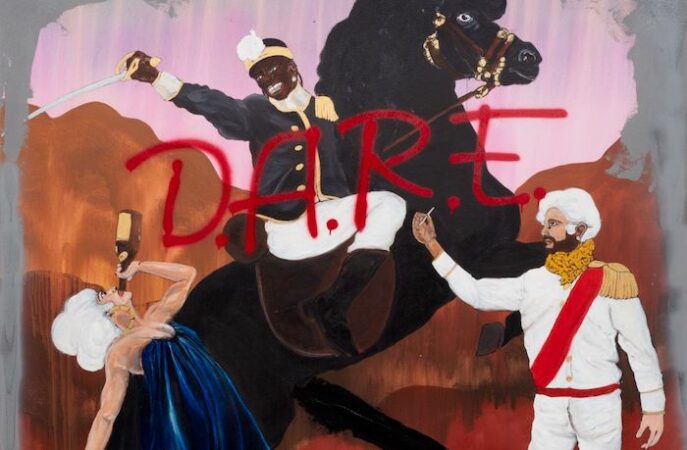
by: Ellen C. Caldwell
for Riot Material
In En Garde/On God, Blum & Poe showcases the work of artist Umar Rashid (also known by the pen name Frohawk Two Feathers). Featuring thirteen large paintings and one sculpture in Rashid’s hallmark style, the exhibition highlights works that are bold in both color and story, backed by lengthy titles which are equally vivid and emotive in their humor and wit. Using his imagined “Frenglish Empire” as key players in a revisionist history, Rashid uses biting humor to question, underline, and undermine contemporary and historical issues around the construction of race and class, the perpetual cycle of colonial violence, the historical erasure and survivance of Los Angeles’ Tongva and Chumash people, and the legacies of imperialism that haunt the present and future. Building on a practice of about 18 years, En Garde/On God moves Rashid’s work into decidedly new territory.
Rashid has been crafting the epic of the fictitious Frenglish Empire since 2003, as he imagined what the world might have looked like had France and England united. But this is not a strict or static revisionist history. Instead, Rashid recreates the past with malleable points in time, culled from colonial history and Afrofuturist imaginings. Through monumental history paintings, saturated colonial portraits, a faux-aged map, and even a satirical wooden coffin with mechanical features, he comments on the cyclical nature of history, on human foibles, and on an imagined temporality, featuring a host of expanded roles for people of color, who have often erased from colonial renderings of the historical record. In this way, he describes his work as existing in the past, present, and future. Rashid collapses time, reason, and traditional historical narrative in his work, as Franciscan and Jesuit priests intermingle with Black and white Jesus figures who preside over humanity from lowriders of the past or Landspeeders of the future. Indigenous Tongva characters are shapeshifters and Transformers, heroically battling and successfully attacking the priests’ international space station (which they had disguised as St. Basilica’s Cathedral)…
